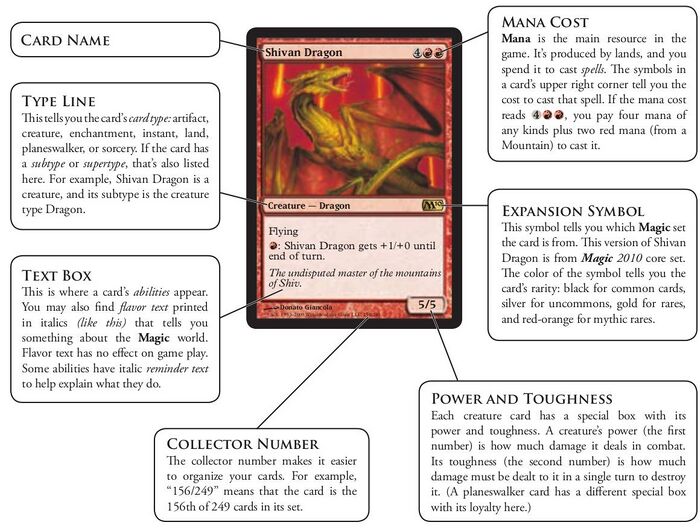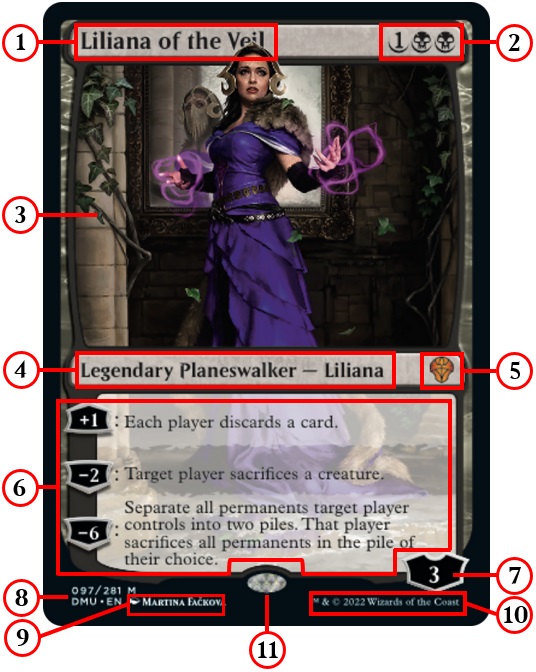Card: Difference between revisions
>DimirPickpocket324 m (→Counterfeits) |
>@DeletedUser40376198 No edit summary |
||
| Line 9: | Line 9: | ||
***'''108.2a''' In the text of spells or abilities, the term "card" is used only to refer to a card that's not on the battlefield or on the stack, such as a creature card in a player's hand. For more information, see section 4, "Zones." | ***'''108.2a''' In the text of spells or abilities, the term "card" is used only to refer to a card that's not on the battlefield or on the stack, such as a creature card in a player's hand. For more information, see section 4, "Zones." | ||
**'''108.3.''' The ''owner'' of a card in the game is the player who started the game with it in his or her deck. If a card is brought into the game from outside the game rather than starting in a player's deck, its owner is the player who brought it into the game. If a card starts the game in the command zone, its owner is the player who put it into the command zone to start the game. Legal ownership of a card in the game is irrelevant to the game rules except for the rules for ante. (See rule 407.) | **'''108.3.''' The ''owner'' of a card in the game is the player who started the game with it in his or her deck. If a card is brought into the game from outside the game rather than starting in a player's deck, its owner is the player who brought it into the game. If a card starts the game in the command zone, its owner is the player who put it into the command zone to start the game. Legal ownership of a card in the game is irrelevant to the game rules except for the rules for ante. (See rule 407.) | ||
***'''108.3a''' In a [[Planechase]] game using the single planar deck option, the planar controller is considered to be the owner of all the plane cards. See rule 901.6. | ***'''108.3a''' In a [[Planechase (variant)|Planechase]] game using the single planar deck option, the planar controller is considered to be the owner of all the plane cards. See rule 901.6. | ||
***'''108.3b''' Some spells and abilities allow a player to take cards he or she owns from outside the game and bring them into the game. (See rule 400.10b.) If a card outside that game is involved in a '''Magic''' game, its owner is determined as described in rule 108.3. If a card outside that game is in the sideboard of a '''Magic''' game (see rule 100.4), its owner is considered to be the player who started the game with it in his or her sideboard. In all other cases, the owner of a card outside the game is its legal owner. | ***'''108.3b''' Some spells and abilities allow a player to take cards he or she owns from outside the game and bring them into the game. (See rule 400.10b.) If a card outside that game is involved in a '''Magic''' game, its owner is determined as described in rule 108.3. If a card outside that game is in the sideboard of a '''Magic''' game (see rule 100.4), its owner is considered to be the player who started the game with it in his or her sideboard. In all other cases, the owner of a card outside the game is its legal owner. | ||
**'''108.4.''' A card doesn't have a controller unless that card represents a permanent or spell; in those cases, its controller is determined by the rules for permanents or spells. See rules 110.2 and 111.2. | **'''108.4.''' A card doesn't have a controller unless that card represents a permanent or spell; in those cases, its controller is determined by the rules for permanents or spells. See rules 110.2 and 111.2. | ||
Revision as of 01:26, 12 August 2014
In Magic: The Gathering, the word card always refers to a Magic card with a Magic card front and a Magic card back, or to double-faced cards. Tournament-legal cards are 2.5 x 3.5 inches (6.35 x 8.89 cm) and weigh 0.064 ounces (1.814 grams). [1] Nonfoil cards are approximately 0.012 inches (0.305 mm) thick.
A card is only referred to as a "card" by game rules or effects when in a player's hand, library, or graveyard, or in exile. Tokens are never considered cards, even if cards are used to represent them. When a card has been cast and is on the stack waiting to resolve, the game refers to it as a "spell." When a card is on the battlefield, the game refers to it as a "permanent," or simply by its type or subtype.
Rules
Lua error in Module:CR at line 549: Unknown error, multiple lookups .
From the ()
Parts of a card
On a card, several elements can be distinguished. [2] [3]
| Non-planeswalker cards (general) | Planeswalker cards |

|
 1: name; 2: mana cost; 3: illustration; 4: type line; 5: subtypes; 6: expansion/set symbol; 7: text box for rules text and/or flavor text; 8: illustrator; 9: loyalty; 10: other, sub-text box information (including copyright information and collector's number). 1: name; 2: mana cost; 3: illustration; 4: type line; 5: subtypes; 6: expansion/set symbol; 7: text box for rules text and/or flavor text; 8: illustrator; 9: loyalty; 10: other, sub-text box information (including copyright information and collector's number).
|
Marked cards
Some players and collectors have their cards signed by artists, written on by celebrities, drawn on, or otherwise "embellished". In tournaments it is always the head judge's call as to whether a card is "disruptively" altered. Cards with just signature on them are almost universally acceptable; the fuzziness starts when the whole text box is covered or if the art is obscured too much. Even if the card name is readable, altered cards can be ruled illegal if they seem deceptive to your opponent from a distance. [4]
Counterfeits
Illegal counterfeit boxes of Magic as well as counterfeit single cards have been produced and distributed. Most counterfeits are easily distinguishable as fakes by a different color, gloss coating or texture. [5] Wizards of the Coast takes legal action, when appropiate. [6]
References
- ↑ Kelly Digges (April 24, 2007). "Ask Wizards - April, 2007". magicthegathering.com. Wizards of the Coast.
- ↑ Ted Knutson (October 21, 2006). "Anatomy of a Magic Card". magicthegathering.com. Wizards of the Coast.
- ↑ Ken Nagle (June 15, 2009). "Convertible Design". magicthegathering.com. Wizards of the Coast.
- ↑ Aaron Forsythe (April 16, 2002). "Customizing Your Collection". magicthegathering.com. Wizards of the Coast.
- ↑ Mike Elliott (April 26, 2004). "Buyer Beware". magicthegathering.com. Wizards of the Coast.
- ↑ Template:NewRef